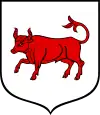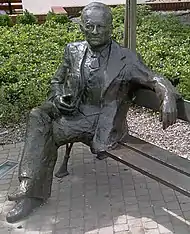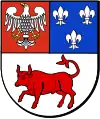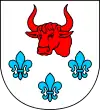Turek, Poland
Turek [ˈturɛk] is a town in central Poland with 31,282 inhabitants as of 2009. It is the capital of Turek County.
Turek | |
|---|---|
 Jesus Holiest Heart church | |
 Coat of arms | |
| Motto(s): Turek zawsze po drodze / Miasto silne jak tur. Turek always on your way / City strong as an aurochs | |
 Turek  Turek | |
| Coordinates: 52°1′N 18°30′E | |
| Country | |
| Voivodeship | Greater Poland |
| County | Turek County |
| Gmina | Turek (urban gmina) |
| First mentioned | 1136 |
| City rights | 1341 |
| Government | |
| • Mayor | Romuald Antosik |
| Area | |
| • Total | 16.16 km2 (6.24 sq mi) |
| Elevation | 113 m (371 ft) |
| Population (2009) | |
| • Total | 31,282 |
| • Density | 1,900/km2 (5,000/sq mi) |
| Time zone | UTC+1 (CET) |
| • Summer (DST) | UTC+2 (CEST) |
| Postal code | 62-700 |
| Area code(s) | +48 63 |
| Car plates | PTU |
| Website | http://www.bip.um.turek.pl |
Turek has been situated in the Greater Poland Voivodeship since 1999; it was in Konin Voivodeship from 1975 to 1998.
History

Turek is first mentioned in the historical record 1136, when it was listed as belonging to the archbishops of Gniezno. It received its city rights in 1341.[1] Administratively it was located in the Kalisz Voivodeship in the Greater Poland Province of the Polish Crown.
Turek was annexed by Prussia in 1793 in the Second Partition of Poland, regained by Poles and included within the short-lived Duchy of Warsaw in 1807, and included within so-called Congress Poland in 1815, soon forcibly integrated with the Russian Empire. It was then capital of a district within the Kalisz Governorate.[2] Following the end of the First World War in 1918, Turek became part of the Second Polish Republic as the country regained independence.
With the German invasion of Poland and the outbreak of the Second World War in September 1939, Turek was occupied by the Wehrmacht and annexed by Nazi Germany. It was administered as part of the county or district (kreis) of Turek within Reichsgau Wartheland. The Polish population was subjected to expulsions, confiscation of property, deportations to Nazi concentration camps and murder. In autumn of 1939, the Einsatzgruppe VI carried out a number of executions of Poles at the local market.[3] Teachers from Turek were among Polish teachers murdered in the Mauthausen concentration camp.[4] The first expulsion of 160 Poles was carried out in December 1939, and the expellees' shops, workshops and houses were then handed over to German colonists as part of the Lebensraum policy.[5] During the German occupation, the nearly 3,000 Jews in Turek were brutalized, forced into an overcrowded ghetto in 1940, starved, and robbed of all their possessions. In 1941, some men were sent to forced labour camps near Poznań, but the majority of Turek's Jews were sent to a rural ghetto in Kowale Pańskie. In July 1942, most of them were sent to the Chełmno extermination camp where they were gassed immediately. Only around 30 Turek Jews survived the war.
With the arrival of the Red Army in 1945 and the end of the war, Turek was integrated into the People's Republic of Poland.
International relations
Notable people

- Roch Rupniewski (1802/04–1876), Polish poet and activist, participant in the November Uprising, born in Turek
- Ludwik Grossman (1835–1915), Polish musician, composer and conductor, born in Turek
- Józef Mehoffer (1869–1946), Polish painter and decorative artist
- Henryk (Henoch) Glicenstein (1870–1942) was a Polish-American sculptor
- Felicjan Sławoj Składkowski (1885–1962), Polish physician, general, politician, Prime Minister of Poland
- Marian Cieplak (1893–1996), Polish diplomat, statesman, parliamentarian, director of the gymnasium in Turek before World War II[6]
- Mieczysław Smorawiński (1893–1940), Polish general, victim of the Katyn massacre
- Włodzimierz Pietrzak (1913–1944), Polish poet, member of the Polish resistance movement in World War II, fallen in the Warsaw Uprising
- Tomasz Gatka (born 1974), Polish bobsledder
See also
- Józef Piłsudski monument in Turek
References
- Megargee, Geoffrey (2012). Encyclopedia of Camps and Ghettos. Bloomington, Indiana: University of Indiana Press. p. Volume II, 109-110. ISBN 978-0-253-35599-7.
- "Kalisz". In Encyclopædia Britannica. Volume 15. p 642. Accessed via Google Books 10/6/11.
- Maria Wardzyńska, Był rok 1939. Operacja niemieckiej policji bezpieczeństwa w Polsce. Intelligenzaktion, IPN, Warszawa, 2009, p. 207 (in Polish)
- Maria Wardzyńska, Był rok 1939. Operacja niemieckiej policji bezpieczeństwa w Polsce. Intelligenzaktion, p. 215
- Maria Wardzyńska, Wysiedlenia ludności polskiej z okupowanych ziem polskich włączonych do III Rzeszy w latach 1939-1945, IPN, Warszawa, 2017, p. 182 (in Polish)
- Małgorzata Smogorzewska: Posłowie i senatorowie Rzeczypospolitej Polskiej 1919-1939. Słownik biograficzny, tom I: A-D, Wydawnictwo Sejmowe Warszawa 1998

